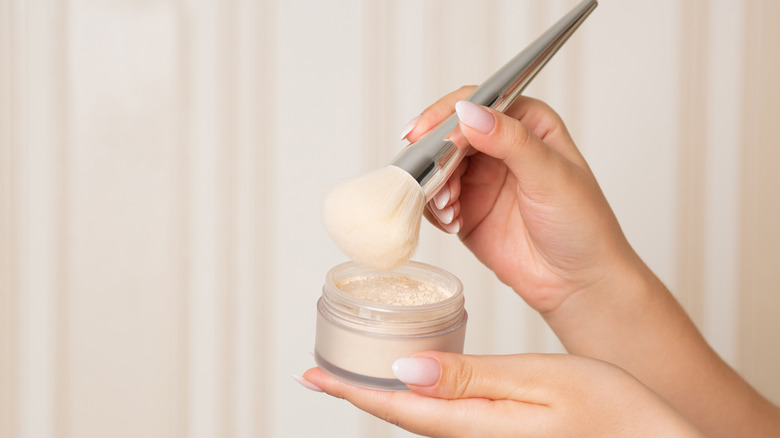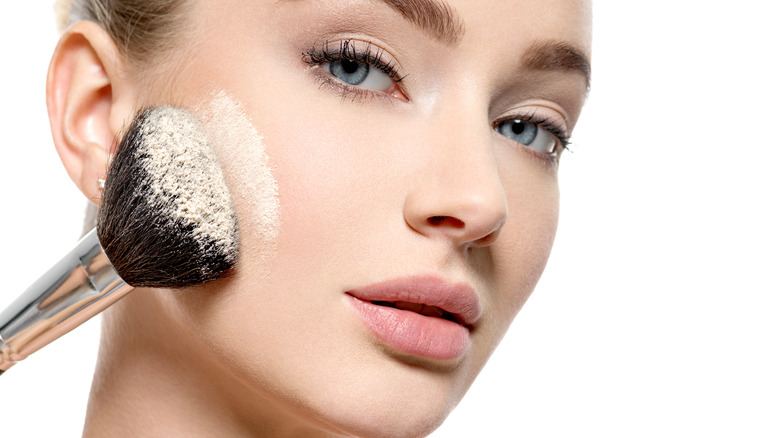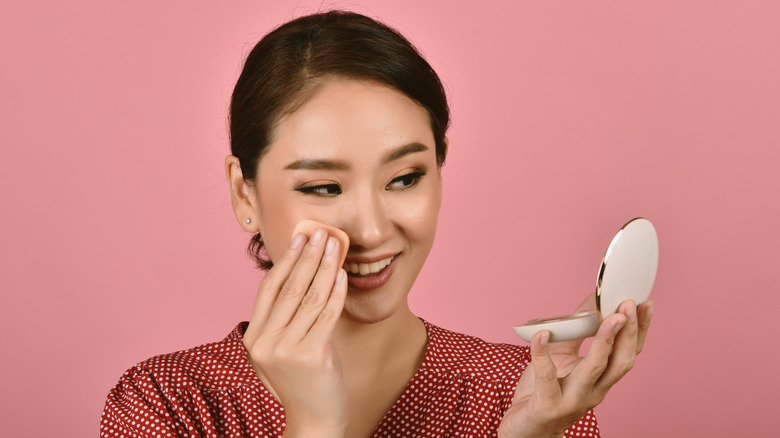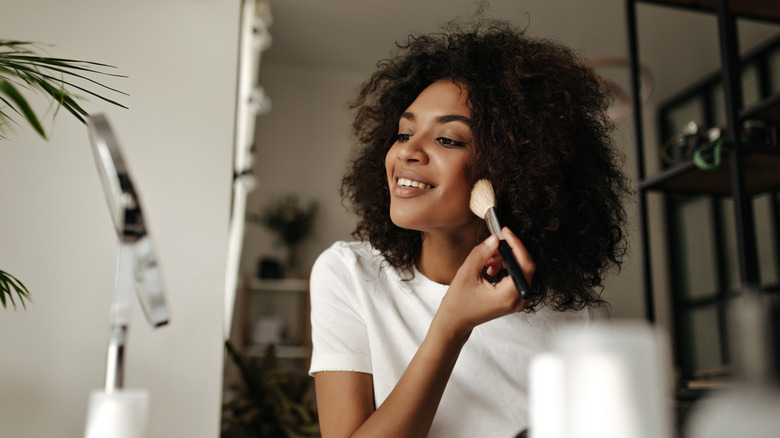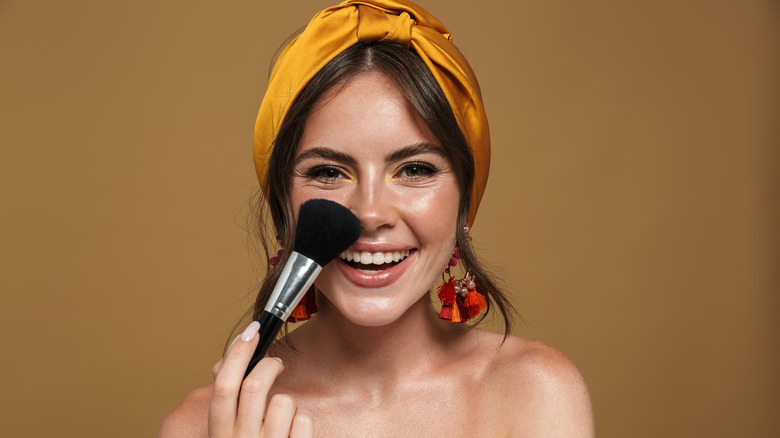Mistakes You Don't Want To Make With Setting Powder
When used properly, setting powder can be one of the biggest assets to your makeup arsenal, and can help give your face a smooth, flawless finish. Similarly to how you would use hairspray when finishing off your curls or blowout before leaving the house, setting powder acts as the "finishing touch" for your makeup look. "Setting powder's purpose is to hold makeup on all day and night," says celebrity makeup artist Alexa Rae Johnson (via Ipsy). "This powder soaks up excess oils in the skin as well as in liquid foundation products in order to hold liquid makeup on for a longer amount of time. Essentially this is what prevents you from turning into an oily mess with foundation dripping down your face after a couple of hours of wear."
Unfortunately, many people apply setting powder incorrectly or don't use the right type for their skin type, which can prevent your makeup from looking as fabulous as it should. "It's important to know how much coverage you're looking for, what type of consistency you prefer — whether pressed or loose — and what type of finish you want, whether it be matte, natural, or radiant," explains celebrity makeup artist Anthony Nguyen (via Byrdie). This all comes down to the kind of setting powder you use, how much you use, and the way you apply it. Avoiding some of the most common setting powder mistakes can help your makeup look flawless while ensuring it stays put all day and night.
Using too much
As beneficial as a good setting powder may be to your makeup game, there's still such a thing as using too much. Overdoing it on the setting powder can make your face look overly chalky, and makeup artist Anthony Nguyen says wearing too much can cause it to settle into fine lines and dry areas on your face, making them more pronounced (per Byrdie).
"By over-powdering, you create a flat mask-like look and destroy your natural radiance," makeup artist Gita Bass says via HuffPost. Instead of going in heavy-handedly and applying your setting powder all over your face, choose a light powder and only apply it in the areas that really need it, such as your t-zone, which tends to see the most oil production. If you do end up applying too much, don't panic — your makeup look can still be salvaged. Brushing off any excess powder with a clean, fluffy brush or puff will help take care of some of the excess powder, while Stewart, Director of Artistry and Education for Make Up Forever, recommends finishing a particularly powdered look with a hydrating setting spray (per Seventeen). This will help control any excess powder while leaving your skin looking dewy and natural as opposed to like you just dipped your face in a vat of powder.
Using the wrong formula
As with most other beauty products, there is no one-size-fits-all approach when it comes to setting powder, and the kind best meant for you comes down to the type of finished look you want in addition to the type of skin you have. According to celebrity makeup artist Beau Nelson, "When it comes to loose setting powders, they come in two forms: translucent and colored. Colored works to correct tone, brighten the face, and correct redness. Translucent powders are probably the safest bet since they don't change the color of the foundation and don't add coverage." Nelson adds that pressed powders are also a good option for those looking for a slightly more full-coverage, polished look, while mineral powder offers an even fuller coverage option — though he doesn't recommend using it as a setting powder and wearing it over foundation since it can look cakey (via Allure).
Additionally, any type of setting powder can also have the hidden label of "HD," making it what is known as "finishing powder." While HD powder can create a beautiful blurring effect on the skin, it can also be notoriously tricky to wear — which is why many experts recommend avoiding it altogether. In situations involving flash photography, HD powders can become ultra-reflective, making you look like a ghost. "Unless you're working on a film set, there's no need for it, really," says celebrity makeup artist Daniel Martin (per The Cut).
Applying it too late in your makeup routine
As effective as setting powder can be, it's only able to work its full magic if applied when it's intended to. While many people wait until their full face is dry after applying cream products like foundation and concealer, experts say doing so can diminish the intended effects of the powder altogether. In order to get your setting powder to properly bond with the rest of your makeup products, it's best to apply it while the rest of your products are still wet and tacky — which means you need to work relatively quickly. When you layer a dry powder on top of a wet foundation or CC cream, the bond between the products is strengthened, which helps your makeup stay put all day and night while providing an extra smooth, finished look (per Beauty Blender).
Celebrity makeup artist Daniel Chinchilla tells Allure that before the rest of your makeup completely dries, you should press your setting powder into your skin with a powder puff or a flat-shaped powder brush. Since ideally your foundation will still be a little wet during this process, pressing your powder into the skin as opposed to using buffing or swiping motions will prevent the rest of your makeup from streaking and smearing before it fully dries. Pressing your powder into your skin also allows it to truly "set" your face better and helps your makeup last longer.
Applying it with the wrong tools
As it turns out, the method by which you apply your setting powder makes a much bigger difference than many people realize. Not all beauty tools are the same, and beauty blenders, brushes, and powder puffs all perform differently and will provide a different type of finish. The type of skin you have — oily or dry — will also play a role in determining which tool right for you when applying your setting powder.
Many people apply their setting powders with a damp beauty blender or sponge, since that is what they see beauty influencers doing on YouTube and TikTok. However, Lijha Stewart explains via Seventeen that they are purposefully doing so because they want a really full-coverage look — which might not be what you are going for. If your skin tends to get oily throughout the day, Stewart recommends applying a loose setting powder with a powder puff. "It absorbs oil and creates a velvety matte skin finish," she says. "Typically oilier skin types want to be more matte, therefore more powder should be applied with the puff and pressed into the skin," adds Jason Hoffman, global beauty director of Laura Mercier (via Popsugar). "The opposite goes for drier skin types or those wanting more of a natural glow after setting." If you don't struggle with oil and are looking for a dewy finish with a bit more radiance, use a fluffy powder brush.
